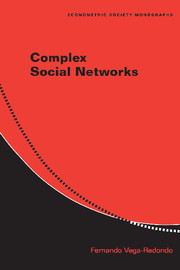Book contents
- Frontmatter
- Contents
- Preface
- 1 Introduction
- 2 Complex Networks: Basic Theory
- 3 Epidemic Diffusion
- 4 Neighborhood Effects in Diffusion and Play
- 5 Searching in Social Networks
- 6 Search, Diffusion, and Play in Coevolving Networks
- Afterword
- A Generating Functions
- B The Ising Model
- C Mean-Field Theory
- Bibliography
- Index
- Econometric Society Monographs
1 - Introduction
Published online by Cambridge University Press: 05 January 2013
- Frontmatter
- Contents
- Preface
- 1 Introduction
- 2 Complex Networks: Basic Theory
- 3 Epidemic Diffusion
- 4 Neighborhood Effects in Diffusion and Play
- 5 Searching in Social Networks
- 6 Search, Diffusion, and Play in Coevolving Networks
- Afterword
- A Generating Functions
- B The Ising Model
- C Mean-Field Theory
- Bibliography
- Index
- Econometric Society Monographs
Summary
THE NEW FIELD OF COMPLEX NETWORKS
In the last decade, the study of complex networks has become a booming field of research with a marked interdisciplinary character. Many different phenomena in the physical, biological, and social worlds can be understood as network based. They build upon some complex (as well as evolving) pattern of bilateral connections among individual entities and the overall performance of the system is largely shaped by the intricate architecture of those connections.
A brief review of alternative domains of application should serve to illustrate the rich diversity of phenomena that are distinctly governed by complex networks. This is the task carried out in Subsection 1.1.1, where the primary aim is to illustrate such diversity with empirical illustrations gathered from a large number of different areas. Next, in Subsection 1.1.2 we elaborate on the idea that, given the nature of the endeavour, a genuinely interdisciplinary approach is well in order in the field of complex networks.
Realms of Application and Empirical Evidence
We may start, as the most tangible, with transportation networks. These include the connections through which modern economies channel the physical movement of all sorts of commodities and signals. Pertaining, for example, to the conveyance of signals, a paradigmatic instance is of course the internet network, the huge mesh of bilateral connections through which bit-codifying electronic impulses across computers are transferred all around the world.
- Type
- Chapter
- Information
- Complex Social Networks , pp. 1 - 27Publisher: Cambridge University PressPrint publication year: 2007



